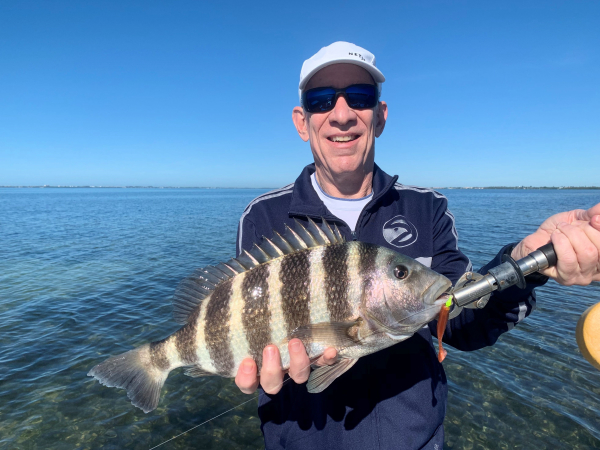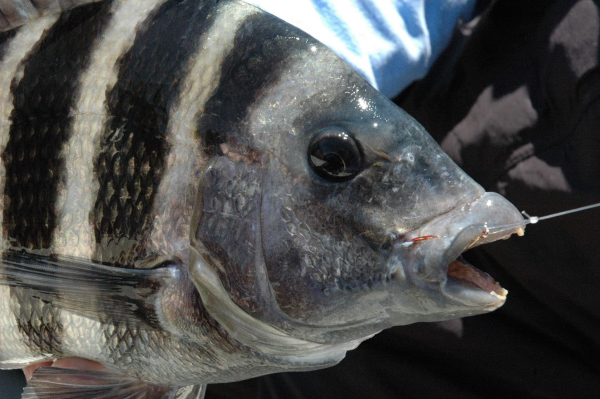
Sheepshead are not considered “sport” fish when caught around piers and pilings, but those that prowl the flats are a whole different animal. (Capt. Rick Grassett)
It ain’t redfish. It ain’t even bonefish or permit. (Well, maybe the most difficult flats fish to catch IS permit, but you can’t find permit in the places most of us can get to.)
Nope, the most challenging of all flats fishing targets is the wily Archosargus probatocephalus, the lowly sheepshead—the convict fish.
Now, before we go on, many of you will note that sheepshead seem to be among the dumbest and least paranoid of fish when found around a pier or dock. You can drop a chunk of fresh shrimp right on their nose from 10 feet away and they will eat it, even though they can see you up there standing with a rod in your hand and a predatory look on your face. Or find ‘em in a pothole in a blackwater creek in winter and they almost jump right into your ice chest, ready to be filleted.
But sheepshead on the flats—there’s a different animal.
Their combination of really good eyes and really bad nerves means that pretty much anything will flush them, even a seagull shadow, and definitely the plunk of a quarter-ounce jig anywhere within 20 feet.
Captain Nathan Chennaux, who guides the back bays around Panama City Beach, says this about them: “Sheepshead are one of the most challenging fish I’ve ever tried to sight fish on the flats. Sometimes they won’t even let you cast a flat-lined live shrimp near them without blowing out. Small hooks, light leader and a long, long cast are requirements, and you’ll also need patience and persistence.”
He forgot to add “a tendency to self-flagellation.” Trying to target sheepshead on the flats is an enterprise almost sure to end in frustration. It’s almost as bad as trying to catch a permit on a fly.
So, of course, some of us have to do it.
After years of trying it every time one of those fat gray tails popped up on my favorite Tampa Bay flats, I caught exactly two. In the same period I couldn’t count the redfish I fooled in the same areas. Sometimes redfish will try to commit suicide, biting almost at your feet, if you wade quietly.
Sheepshead, never.

Sheepshead are armed with sharp, sheeplike teeth used for munching barnacles, oysters and small crabs, but they also love fresh shrimp. (Frank Sargeant)
I think the sheepies are up there grubbing for bloodworms or fiddlers or maybe ghost shrimp, something that hides in the bottom, because they are always nose down when you see them, never heads up chasing mud minnows or shrimp or mullet fry.
Anyway, the two I caught happened to be positioned so that they had to look directly into the sun to see me, and I was pussyfooting along in waders—not in a boat. Each was in not much over a foot of water, near the east shore area known as Bishop’s Harbor.
On the first, I made a tortuously slow approach, as if I were stalking whitetails, and cast an unweighted fresh shrimp tailhooked on a size 2 short shank hook in front of it. It tipped up and ate it just like fat, striped bonefish.
Surprisingly, that first run of a 3-pound sheepshead on 8-pound gear is a bit bonefish-like, too, though they tend to slow down as soon as they go off the edge of the flat into deeper water.
I caught the second one, maybe 4 pounds, on that same day, about 200 yards farther down the flat—and I never caught another one on those flats or any other, though I’ve seen dozens of them tailing.

Sheepshead can rarely be caught on artificials, but skilled anglers do pull it off now and then. (Savage Lures)
Tailing sheepies can be found up on the flats in just about every bay on the Gulf Coast during the usual warm week or two between cold fronts December through early March. They particularly move up at the same time as redfish do, on sunny afternoons when the water on the flats will warm up faster than the deeper water of the open bays.
Of course, if you only want some sheepshead fillets for the pan, it’s much easier to just head to the nearest barnacle-encrusted pier or bridge, drop a heavily-weighted shrimp tail or fiddler crab straight down on a short-shank sheepshead jig along the pilings, and reel up dinner.
But in the tradition of “sport fishing”—by which I mean doing things that rarely work—catching a sheepie on the flats is right up there with the best worst of them. I can’t wait to try it again.
— Frank Sargeant
Frankmako1@gmail.com